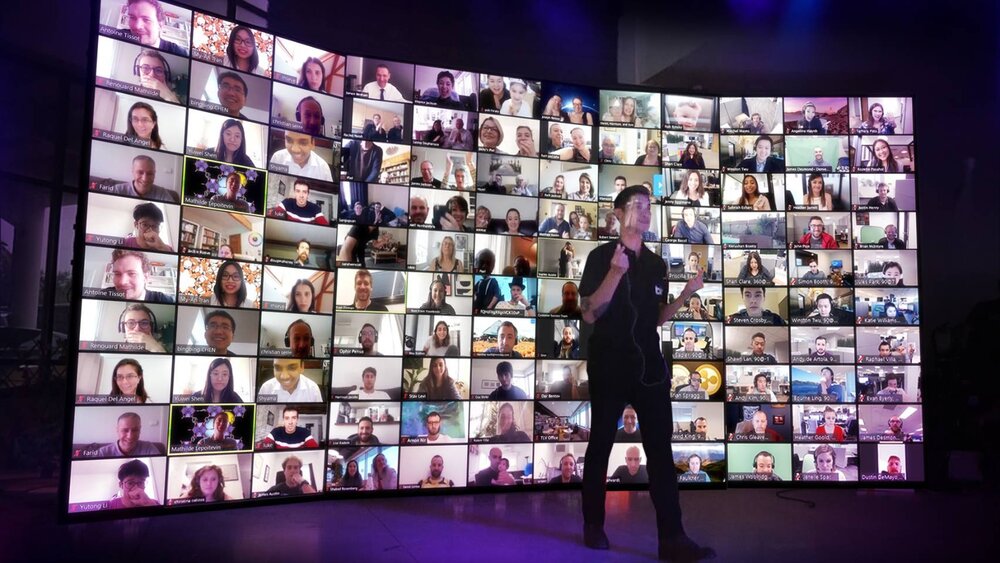In today’s hyper-connected world, the reach of virtual events knows no bounds. Geographic limitations no longer confine businesses, educators or organizations; they can engage international audiences from across the globe with just a few clicks.
However, to truly captivate an international audience, one critical element must be addressed: language. Language translation is not just a nice-to-have feature; it is a powerful tool that can transform your virtual event, making it more inclusive, accessible, and engaging for a diverse audience.

Language: The bridge to global engagement
Language is not just a means of communication—it’s a gateway to understanding. When you host a virtual event, you’re speaking to people from different cultures, regions, and linguistic backgrounds. While English is often the default language in international business, many potential participants may not speak it fluently, or at all. By offering language translation services, you acknowledge and respect the cultural diversity of your audience, making them feel seen and valued.
Providing multilingual content increases your event’s reach and impact exponentially. Attendees are more likely to engage with the material when it’s in their native language, allowing for a deeper connection to the event and its objectives. In essence, language translation is the bridge that turns a virtual event into a truly global experience
Making the right choices for effective translation
The benefits of language translation are clear. However, simply hiring translators isn’t enough; you need to ensure seamless, real-time communication across languages. Executing this effectively, like many attributes of virtual events, requires the right technical support and considered planning.
At BeThere Global we have delivered a range of multi-lingual virtual events for our clients over the years. From utilizing existing translation tools on platforms such as Zoom to building custom designed websites to host multi-language streams we have used a variety of methods to best fit the needs of international online audiences.
With this experience, we have compiled the list below of some of the key considerations and technical choices that we think makes a successful multi-lingual event.
1. Choosing the right languages
Selecting the languages for your event may seem straightforward – just pick the dominant languages of your audience, right? Not quite. Translation goes beyond just converting words; it requires an understanding of the cultural and linguistic nuances of your audience. For example, in one of our recent virtual events, we initially planned to translate presentations from English into another language, assuming attendees would benefit from hearing the event in their native tongue.
However, after consulting with language experts and researching our audience, we realized that participants would actually prefer asking questions in their language while the English-speaking panelists received the translations. This adjustment allowed for a more inclusive and interactive experience, empowering the audience to participate confidently in their own language and get the most out of the Q&A session.
Understanding the unique preferences of your audience will inform the translation services you offer to make sure they are genuinely valuable and effective. Considering this at the outset of the project, will ensure that you take the right steps to deliver this.
2. Selecting the right technology
Once you’ve identified the right language, you need the right tools to execute your translation strategy. There are various options to consider:
- Simultaneous interpretation : Professional interpreters translate the speaker’s words in real-time as they are speaking. Participants can listen to the translated audio in their preferred language via different channels. Many well-known platforms such as Zoom and Microsoft Teams have existing features within their events offerings to cater for live translation.
- Live subtitling and captioning: Real-time transcription and captions can enhance accessibility for attendees who prefer reading translations and has the benefit of also catering for those who have hearing impairments. Many solutions on the market use AI-driven tools for fast automated captioning and translation
Technical reliability is critical – any delays or glitches can disrupt the flow of your event. When choosing a platform, ensure that it can handle the load of multiple languages without compromising on quality or speed.
3. Balancing automation with the human touch
While AI-driven translation tools have advanced significantly, they can’t always capture the subtleties of human speech. Industry-specific jargon, cultural references, and idiomatic expressions often require a human touch to ensure the message is conveyed accurately.
Having human interpreters or editors involved in reviewing AI-generated content can elevate the quality of your translation services. For example, pre-recorded videos may benefit from manually edited subtitles to ensure translation clarity and accuracy.
4. Adapting to different content types
Virtual events often include a mix of live presentations, pre-recorded content, and interactive sessions. Each format may require a different approach to translation. Simultaneous interpretation is ideal for live presentations, while pre-recorded videos can be enhanced with multilingual subtitles or voice-overs. Interactive sessions, like Q&As, may require on-the-fly translation to facilitate two-way communication.
Tailoring your translation approach to each content type ensures that your audience can engage fully, no matter how the information is presented.
The competitive edge of multilingual events
Incorporating language translation into your virtual events doesn’t just break down language barriers – it gives your event a significant competitive edge. It enables you to reach a broader audience, engage attendees more deeply, and create a truly global event that leaves no one out.
As virtual events continue to grow in popularity, the ability to connect with an international audience will set you apart. By investing in the right technology, planning with cultural awareness, and keeping the human element at the forefront, your virtual event can become a powerful platform for global engagement, making a lasting impression on every attendee, no matter where they are in the world.



